Palm fruits have been part of the human diet for centuries, shaping traditions and local economies around the world. Besides their sweet or nutty taste, palm fruits are full of vitamins, minerals, fiber, and other nutrients that help keep the body healthy. In many cultures, they are also used as vital ingredients in medicines, oils, and everyday dishes.
But with over 2,500 palm species scattered around the globe, it can be tricky to know exactly which fruit belongs to which tree. To make things simple, let’s narrow things down to one striking group: orange palm fruits. Their color instantly stands out in the wild and at grocery stores, sparking curiosity about their identity. Again, orange color often means the fruit has beta-carotene and vitamin A, which help keep our eyes, skin, and immune system healthy.
Without further ado, let’s take a closer look at some of the most notable orange fruits you’ll find growing on palm trees.
1. Jelly/Pindo Palm Fruit
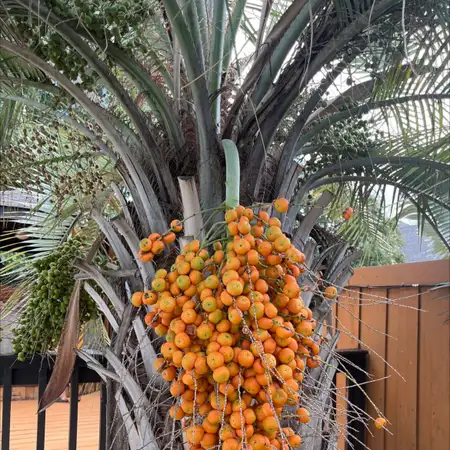
The pindo palm, also called the jelly palm, is native to South America but has found a second home in the southern U.S. Come summer, it hangs heavy with clusters of cherry-sized fruits that glow from yellow to red. Bite into one, and you’ll get a juicy mix of sweet and tart, almost like pineapple. People often turn them into jellies, jams, or even a refreshing homemade wine.
2. Date Palm Fruit
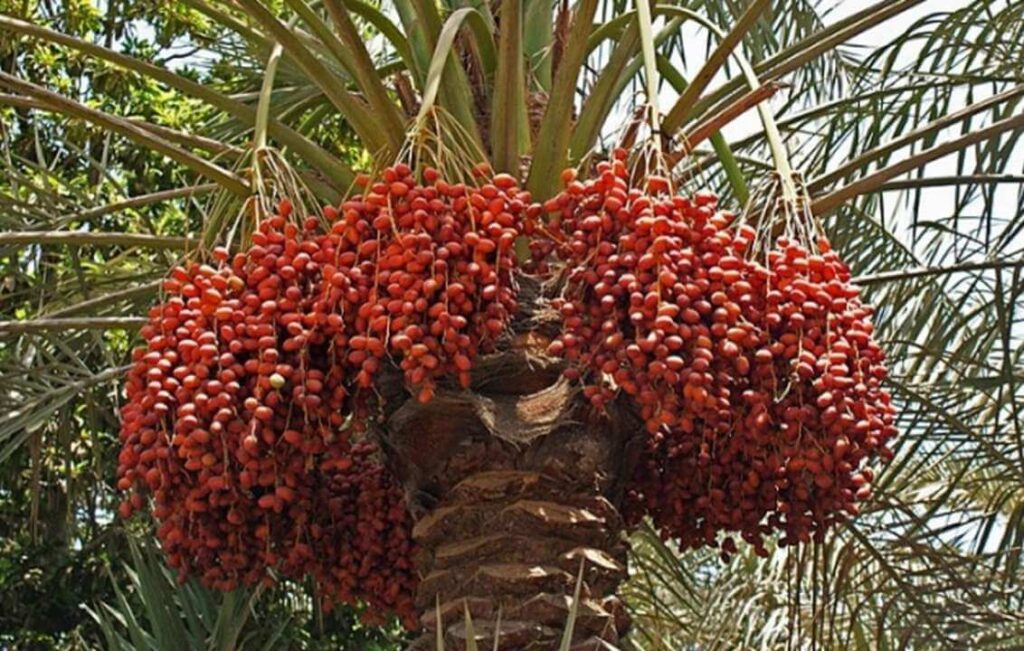
The date palm has been treasured for thousands of years, and it’s easy to see why. Its fruits, known simply as dates, grow in heavy clusters that can weigh several kilos each. Dates begin green, shift to yellow, and finally ripen into golden or reddish-brown jewels, depending on the variety. Fresh dates are soft, mildly sweet, and full of iron and potassium—making them a natural pick-me-up for energy and recovery.
3. Peach Palm Fruit
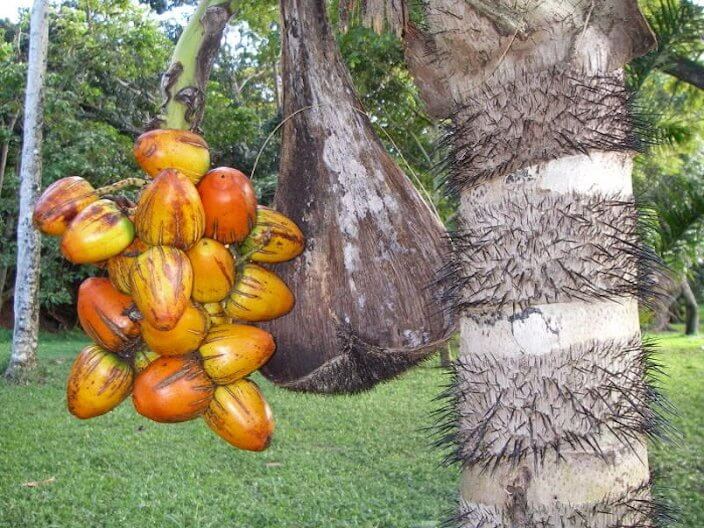
The peach palm fruit is a Central and South American staple that’s often boiled and enjoyed with a touch of salt or honey. Its flesh is a little dry and starchy, making it perfect for hearty meals, and it’s even used to brew traditional drinks. Packed with protein and carbohydrates, it’s a valuable energy food, though it must be cooked to remove natural alkaloids. The bright orange varieties are especially striking, with oil rich in beta-carotene that locals use in cooking.
4. Oil Palm Fruit
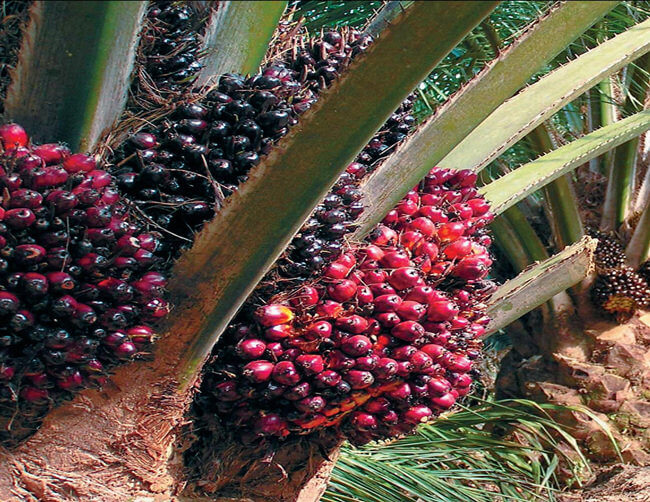
The oil palm fruit, native to West and Central Africa, grows in large clusters of small, reddish, plum-sized fruits. Both the fleshy outer layer and the kernel within are packed with oil, making it one of the world’s most important oil crops. Today it’s widely cultivated not only in Africa but also across Malaysia and Indonesia. Palm oil extracted from the fruit finds its way into countless everyday products—from cooking oil and baked goods to soaps, cosmetics, candles, and even biofuels.
5. Foxtail Palm Tree Fruit
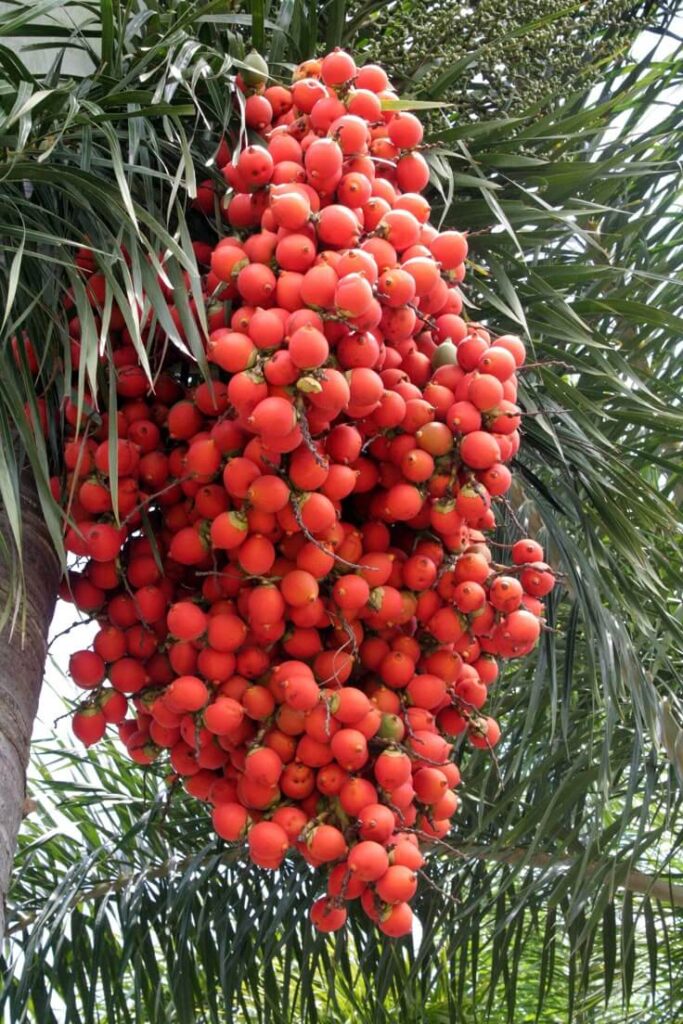
The Foxtail Palm (Wodyetia bifurcata), admired for its lush, feathery fronds, also produces striking clusters of fruit. Each oval fruit grows to about two inches long and contains a single seed. They begin green, gradually ripening into vibrant shades of red to orange-red, adding an ornamental touch against the palm’s elegant crown. While visually stunning, the fruits are not edible, serving instead as a decorative feature that enhances the tree’s tropical appeal.
6. Arecanut (or Betel Nut) Palm Fruit

The Arecanut, also known as the Betel Nut Palm (Areca catechu), is widely grown across tropical Asia and parts of Africa for its seeds, which are chewed for their stimulating effects. Despite its name, the areca nut is not a true nut but the seed of a berry. The fruit starts off green, with a soft inner seed that can be easily cut. As it ripens, the outer husk turns yellow to orange, and the seed inside hardens, eventually becoming tough and woody. At this stage, special cutters are needed to slice it. The nuts are sold fresh, dried, or cured, and are most commonly used wrapped in betel leaves as a traditional chew with stimulant properties.
7. Chilean Wine Palm Fruit
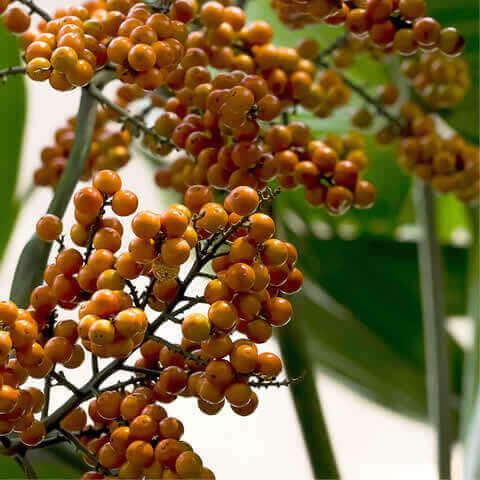
The Chilean wine palm produces small, round fruits that start out green before ripening to a rich golden-yellow. Each fruit is about the size of a plum and contains a single hard seed inside. Though the pulp is edible, it is not widely sought after for its flavor. The real treasure lies within the seed: once cracked open, the nut inside—known as coquito or “little coconut”—has a sweet, coconut-like taste and texture. These miniature “coconuts” are a popular snack in parts of South America and are sometimes used in sweets and confections.
8. Canary Island Date Palm
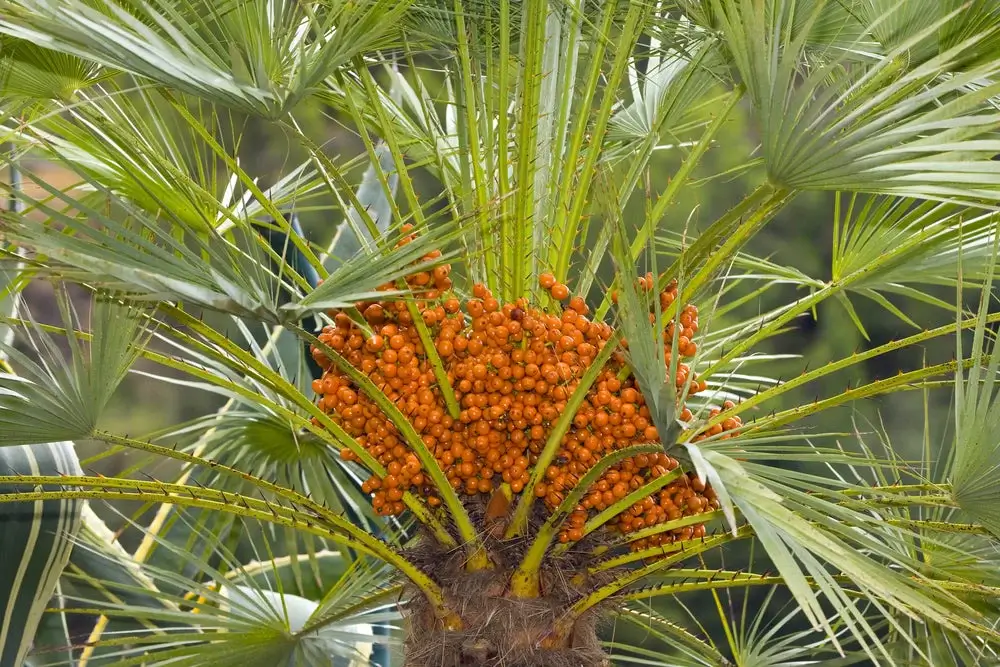
Native to the Canary Islands off Africa’s coast, this stately palm can reach up to 25 meters, often forming dense canopies that block light from the ground below. Its fruits are small, oval drupes that turn from yellow to orange when ripe, about 2 cm long with a single large seed inside. While the pulp is edible, it is rather bland compared to the true date palm, Phoenix dactylifera. The tree itself holds more cultural than culinary value, serving as one of the official symbols of the Canary Islands.
9. Doum Palm Fruits
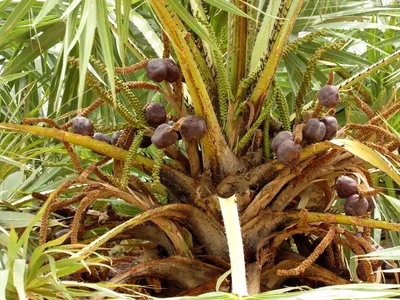
The doum palm, or gingerbread fruit, is a hardy African treasure known for its sweet, wood-textured nut and drought resistance. Popular in Sudan, it’s eaten raw, brewed into drinks, or ground into remedies. Traditionally, it’s used to ease stomach pain, urinary issues, and high blood pressure, while boiled leaves serve as eyewash for conjunctivitis. Beyond its health uses, the fruit also supports handicrafts, making the doum palm both a cultural and medicinal staple across Africa.
10. Chowghat Orange Dwarf Coconut
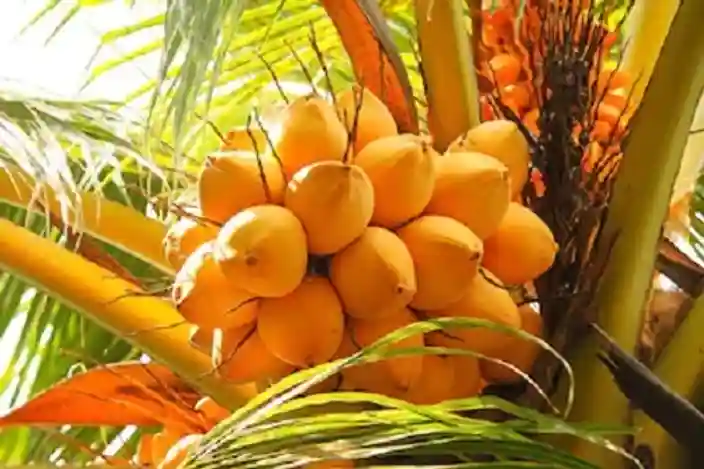
The Chowghat Orange Dwarf coconut is a prized variety from India, loved for its sweet, refreshing tender water. Its vibrant orange fruits stand out, and the tree begins producing in just 2.5 years—much earlier than most coconuts. With an impressive yield of 200–250 coconuts annually, it is both decorative and productive. Farmers and home growers value it as a reliable source of tender coconuts, offering a perfect blend of beauty, taste, and early harvest.
11. Awara Palm

The Awara Palm (Astrocaryum vulgare) is cherished in Guyana and French Guiana for its sweet, bright orange fruits. Growing in sandy soils and often seen in groves, the tree produces oval fruits with juicy pulp rich in Vitamin A. Inside lies a black core with an almond-like kernel. Known by many names across South America (like wara, owara or awarra, etc), the Awara palm is valued both for its flavorful fruit and for the oil it yields, with mature trees producing over 100 pounds annually.
12. The Queen Palm (Cocos palm)
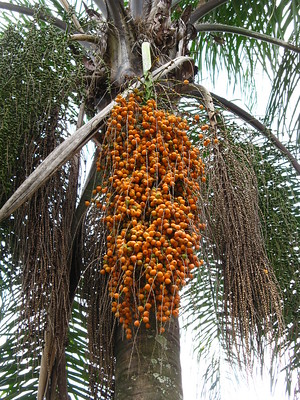
The Queen Palm (Syagrus romanzoffiana), also called cocos palm or Jerivá, is a graceful ornamental tree widely planted across the tropics. Native to woodlands of Argentina, Brazil, Paraguay, Uruguay, and Bolivia, it has since spread far beyond South America. Its clusters of bright orange fruits have a fibrous, sticky pulp with a sweet taste likened to plum mixed with banana.
13. Macaw Palm
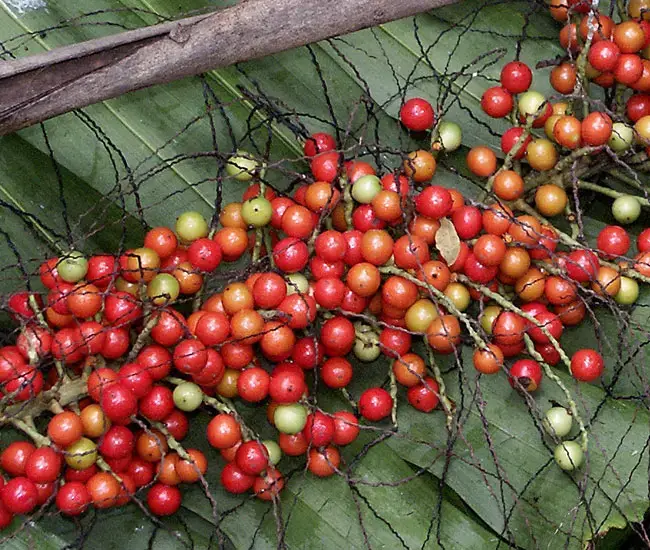
The Macaw Palm (Aiphanes minima), native to the Caribbean, is known for its spiny trunk and graceful feathery fronds. It produces small green fruits that ripen to red or yellow, each with a tough shell encasing a single nut-like seed. The seed’s white core has a mildly sweet, coconut-like flavor, while the pulp is sticky and slightly sweet. With its striking look and edible fruit, this palm is both ornamental and practical, though best suited for outdoor growth.
14. Formosan Palm
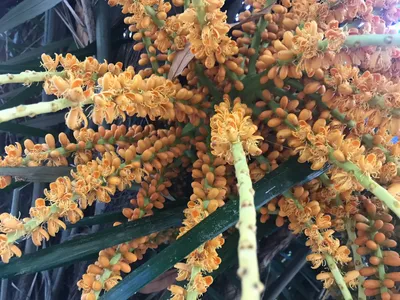
The Formosan Palm (Arenga engleri), also called Formosa palm, is a compact clustering species admired in landscapes for its beauty and manageable size. Growing up to 10 feet tall, it spreads wide with lush, fishtail-shaped leaves reaching eight feet in length. Its sweetly fragrant flowers appear in shades of red, orange, or green and develop into small, round fruits that ripen red to purple. Ornamental and hardy, this palm brings tropical charm without overwhelming space
